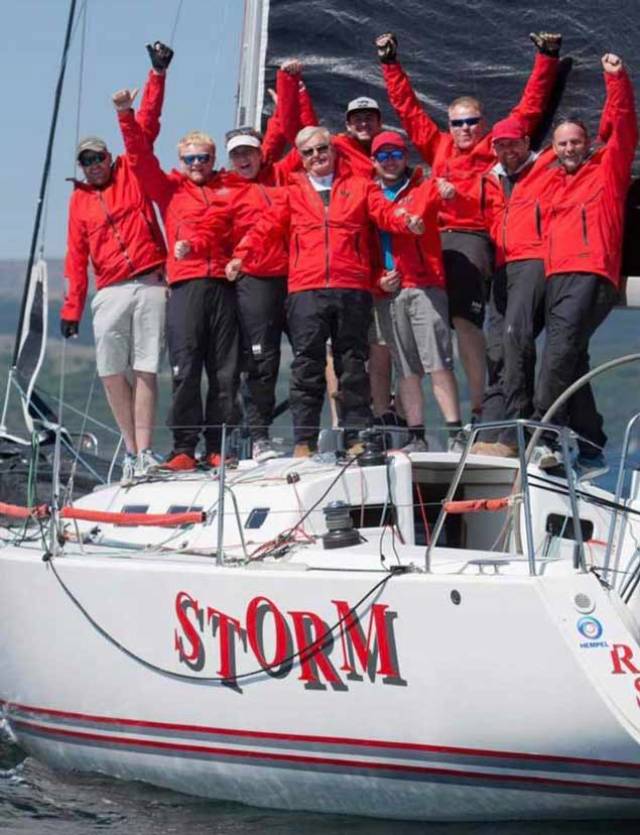The great Danish sailor Paul Elvstrom famously commented that it was much easier to create a completely new racing boat with top class potential than it was to create a successful Class Association with global reach to give proper support to its subsequent development writes W M Nixon.
Elvstrom was not only a sailor of a talent that was at genius level. He was a designer, boat-builder, sailmaker and marine innovator of the highest order, with multiple Olympic Gold Medals and World Championships in his CV. And from time to time, he would bring out a new prototype of the highest quality. Yet seldom did these new boats achieve universal popularity with the ultimate accolade of having an enthusiastic and mostly owner-run international class association.
These thoughts were prompted, in a roundabout way, by consideration of this weekend’s Irish J/109 Nationals at Howth, in which local superstar Storm (Pat Kelly HYC, who’s also of Rush SC) is the defending champion, his crew of Fingal friends – usually augmented by Marty O’Leary - having won a scorcher of a 2017 Nationals at the Royal Irish YC last October.
But in other places, Storm is renowned as the Celtic Cup winner of the relatively new RC35 class. For one of the most interesting things about the J/109 in the Irish scene - and particularly the Dublin Bay context – is that she’s all things to all men and women. Certainly, there are national class associations in several countries and an international association in order to keep the class as One-Design as possible. And in the Dublin Bay group, there are clearly defined crewing rules which prevent boats with the significant professional input of a Category 3 sailor in their crew from taking part in the J/109 Irish Nationals.
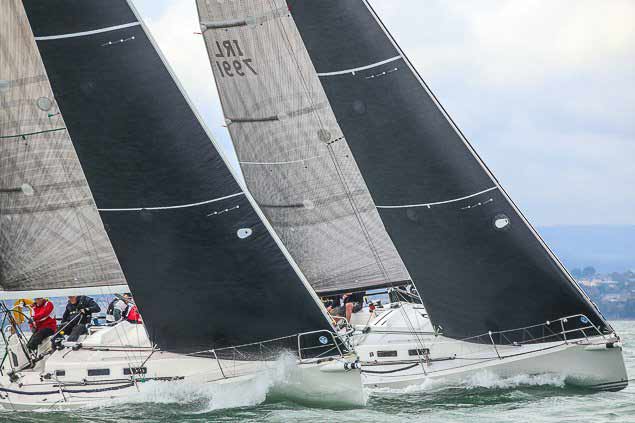 Dublin Bay J/109 racing at top one design level – the annual Nationals are one of the few events where they race as a separate class. Photo Afloat.ie/David O’Brien
Dublin Bay J/109 racing at top one design level – the annual Nationals are one of the few events where they race as a separate class. Photo Afloat.ie/David O’Brien
But nevertheless, flexibility is the keynote of the general approach. Despite the attraction of one-design or semi-one-design racing, the National Championship is one of the few events in which the class in the Greater Dublin area sails specifically as the J/109 Class.
Most of the owners are Dublin Bay Sailing Club stalwarts, and they realise that their class of 15 or so Grand Prix boats make up a significant segment of the upper part of the many and various DBSC cruiser-racer fleet.
This fleet’s turnouts on a Thursday evening are worthy of a detailed sociological study, as many of the crews include people whose only sailing is this one race on a Thursday night, and it has been that way for years. But that’s a kite for flying yet again at another time.
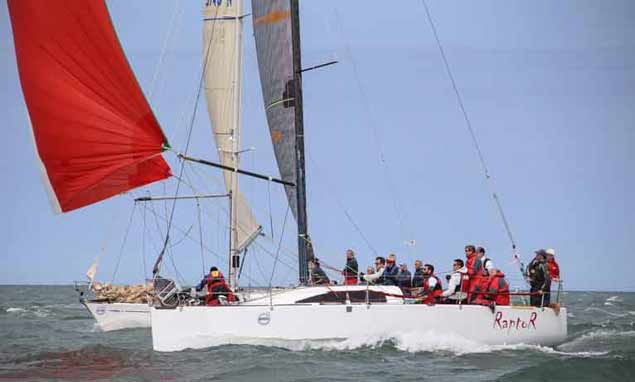 Dublin Bay cruiser-racing is one of the wonders of the Irish sailing scene – and a museum of sailing too. Raptor (Denis Hewitt & partners) may look modern, but she’s a 32ft Mark Mills design of 1996, originally built for Peter Beamish as Aztec
Dublin Bay cruiser-racing is one of the wonders of the Irish sailing scene – and a museum of sailing too. Raptor (Denis Hewitt & partners) may look modern, but she’s a 32ft Mark Mills design of 1996, originally built for Peter Beamish as Aztec
What is relevant is that the J/109 owners realize that if they hived themselves off as a separate class, it would greatly weaken the turnouts in the open divisions. So they prefer to race with their differing IRC ratings as individual boats against each other, and also against boats of other types.
It’s a flexible and mutually-beneficial arrangement which suits the reality of the times we live in. If they were racing as a white-hot and separate One Design class, they’d be under pressure week after week to have a crack crew ready and willing to go, whereas, in the more comfortable space of one of the cruiser-racer divisions, they cut you a bit of slack if frequent turnouts become too onerous.
At least, that’s the way it seems to outsiders. But certainly there’s a different mood to the class when the Irish Nationals are the weekend’s agenda, as they satisfy the need for competitive idealists who dream of a large J/109 one-design class racing week-in, week-out and continually going neck-and-neck in Dublin Bay, whereas realists appreciate that a middle course in class administration produces the most beneficial outcomes.
In achieving this, they work on the J/109’s multi-functional abilities. In a non-One Design context, they were the Boat of Choice in the Beaufort Cup series, the cornerstone of the biennial Cork Week. And the overall winner was John Maybury’s J/109 Joker 2, sailed by Commandant Barry Byrne who, back in June, had also won the Corinthian Division in the Round Ireland Race in the same boat, another feather in the J/109 cap. Then in August some of the J/109s found themselves in Calves Week in West Cork, and after the racing programme was over, owners and their families happily discovered that the J/109 really can be a very effective and comfortable cruiser.
As for the hard-raced Storm, her interests abroad went the opposite way, to the northeast. The Kelly crew have long been successful participants in the Scottish Series in late May, and in 2017 they found themselves involved in a developing Scottish initiative, the RC35 class.
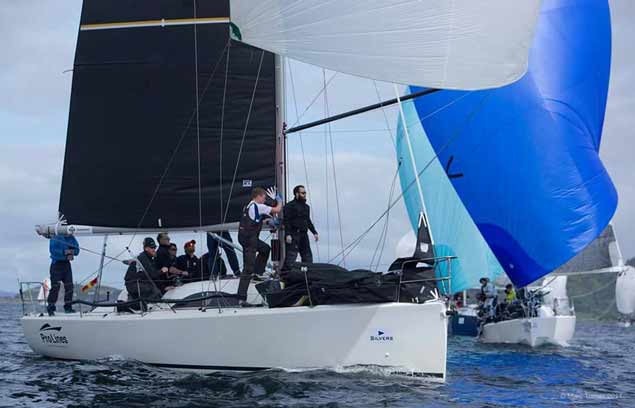 The new RC (Racing Cruiser) 35 Class began to flex its muscles at the Silvers Scottish Series 2017, and the A35 Fool’s Gold (Rob McConnell) from Dunmore East made a mark at this, the class’s national event debut, finishing second overall
The new RC (Racing Cruiser) 35 Class began to flex its muscles at the Silvers Scottish Series 2017, and the A35 Fool’s Gold (Rob McConnell) from Dunmore East made a mark at this, the class’s national event debut, finishing second overall
Sailing in Scotland doesn’t have quite the same rich vein of One Design history which continues to inform much of Dublin Bay racing, and nor does it have the same total single focus which Dun Laoghaire Harbour provides south of the River Liffey, thereby providing continuous interaction among boat-owners.
But in recent years, when the Scottish fleets have got together to race, shrewd and observant participants have noticed that the sport among boats around the 35ft level seemed to have generated its own special popularity, with a sense of community and a high level of competition to match, encouraged by the fact that all boats finished within a reasonably similar time frame.
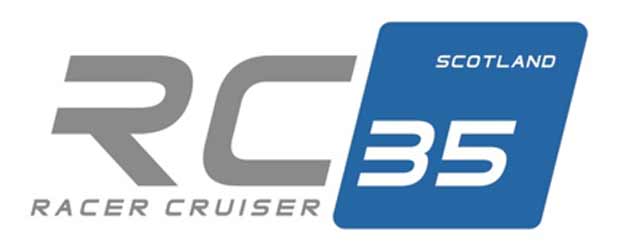 The RC 35 battle flag
The RC 35 battle flag
This was so abundantly evident at 2016’s Scottish Series that by May 2017, folk like John Stamp, Christine Murray, Kevin Aitken and Craig Latimer had hoisted the flag – with the support of Harken and other sponsors - for a new RC35 class for all boats in a tight IRC rating band between 1.015 and 1.040, but with more flexibility on overall length – your pride-and-joy can be anything from 32ft to 38ft in overall length.
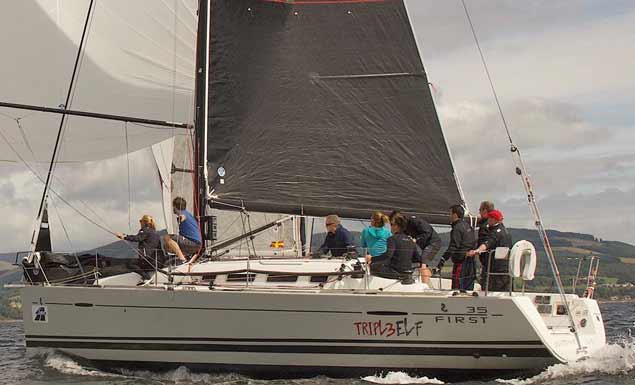 One of the keenest RC35 competitors is the First 35 Triple Elf, owned by Christine Murray who was a founder of the class
One of the keenest RC35 competitors is the First 35 Triple Elf, owned by Christine Murray who was a founder of the class
Like many successful organisational ideas, it wasn’t revolutionary – rather, it rationalised an existing situation to give it a much more attractive and user-friendly structure. Suddenly, lone owners with boats like Beneteau First 36.7s, First 35s, Archambault 35s, Corby 33s, and several Elans and X Boats, found that they were being brought in from the cold to become part of a real warm class with a nascent class association, run by owners for owners with a growing sense of camaraderie. And they’d their own developing programme, where the really keen could commit to the entire season, while others knew they’d have good racing with a welcome guaranteed even if they went to only one regatta.
The J/109s fit very neatly indeed into the lower sector of that tight RC 35 rating band, so by 2017’s Scottish Series, the Irish J/109s found that the IRC 2 Class had also become the RC35 Class, and it fitted them like a glove. Then, by the 2018 Scottish Series, IRC 2 was no more. It was now clearly named the RC35 Class. And the new setup was the best show in town, with the Irish making hay and Storm winning overall by four points from John Hall’s J/109 Something Else from the National YC.
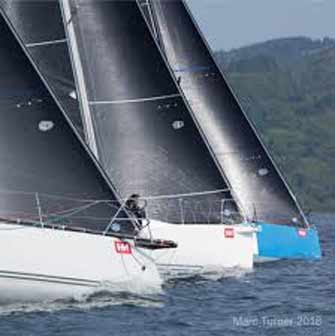 The closest of class racing for three different bow profiles, as they’re all in RC35.
The closest of class racing for three different bow profiles, as they’re all in RC35.
For Storm, it marked the conclusion of a remarkable month in Scotland which made the Kelly family the Afloat.ie “Sailors of the Month” for May 2018, as they’d been so taken with the RC35 concept from their experience in 2017 that they took part (needless to say with success) in the class in racing at the early May Bank Holiday, and Kip Regatta at mid-month before going on to Tarbert and the Scottish Series.
Then they hastened home for the new Wave Regatta at Howth and though in the J/109s they had to concede first overall to Andrew Algeo and partners in Juggerknot, Storm won the tradition Lambay Race around which the Wave Regatta is centred. For a Fingal boat, the 164-boat Lambay Race in itself is every bit as important as the Wave Regatta overall.
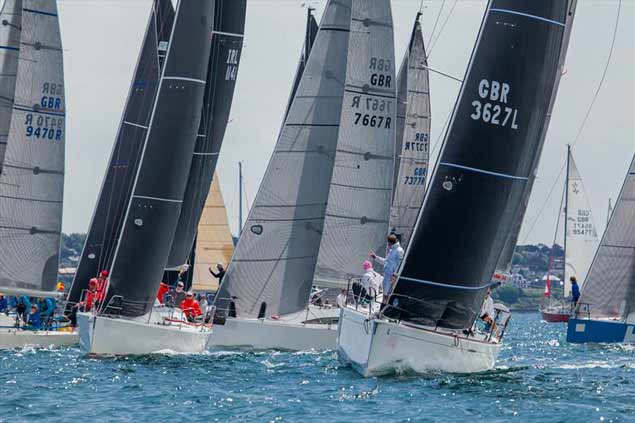 Pre-start jockeying for the RC35s at Bangor Town Regatta on Belfast Lough in July.
Pre-start jockeying for the RC35s at Bangor Town Regatta on Belfast Lough in July.
Meanwhile, up on Belfast Lough the concept of the RC 35 Class had come across the North Channel to be one of the building blocks for the multi-class Bangor Town Regatta in the extended first weekend of July, a new twist on an ancient event jointly organised by Royal Ulster YC and Ballyholme YC. In the end, the relevant class was called IRC 2, but it was the RC35s by any other name, and this time it was a Scottish boat, the Elan 380 Animal (Debbie Aitken) which won, albeit by only one point from Storm in the regatta’s hottest classes.
Back home in Howth in late July, the Kelly family’s efforts were re-directed towards helping tonner Half Tonner Harmony (Johnny Swann) prepare for the Half Ton Classics in Belgium in August, as young David Kelly – Pat’s grandson – is a member of the Harmony crew. Apart from showing the camaraderie of sailing, it was something which underlined the significant difference between Howth’s hyper-keen Half Tonners (we hear the class is soon to have an interesting new addition) and RC35s like the J/109.
For the Half Tonners are a manageable road-trailing proposition, but the J/109s and other RC 35s are too big for most owners to consider the road journey as an integral part of campaigning.
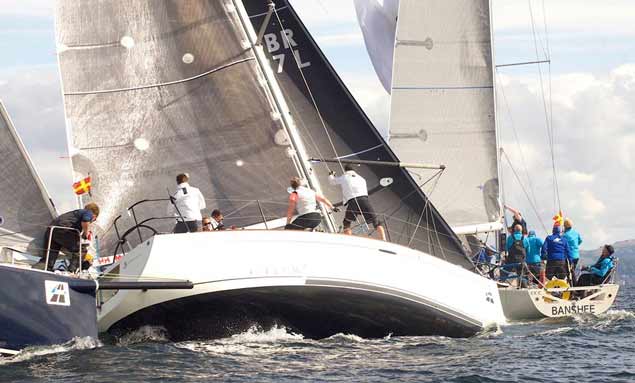 Different boat types, same class…..A typical RC35 melange at the weather mark
Different boat types, same class…..A typical RC35 melange at the weather mark
In other words, the RC35 has the potential to flourish when its various centres are within reasonable sailing distance of each other, and this is why its initial area of growth is along the Firth of Clyde with out-reach to the East Coast of Ireland and North Wales, with the different main events being given an overall structure through the season-long Celtic Cup Trophy. For 2018, this was decisively taken by Storm after she added to her earlier success in the Clyde and Belfast Lough by winning the Welsh IRC Championship off Pwllheli and Abersoch in breezy conditions in August.
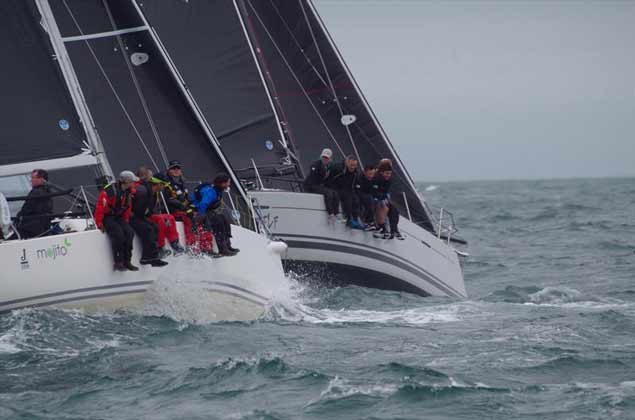 The RC35 Class gets to Wales in August 2018 – ISORA Champion 2017 (and 2018), the J/109 Mojito (Vicky Cox & Peter Dunlop), finds herself drawn into the RC35 class in close contention with Scottish visitor Triple Elf (Christine Murray).
The RC35 Class gets to Wales in August 2018 – ISORA Champion 2017 (and 2018), the J/109 Mojito (Vicky Cox & Peter Dunlop), finds herself drawn into the RC35 class in close contention with Scottish visitor Triple Elf (Christine Murray).
This weekend’s National Championship in Howth is, of course, an exclusively J/109 event, but for next year the RC35 Class are keen to make the Dun Laoghaire Regatta 2019 one of their pillar events. There were preliminary moves back in 2017, but for 2019 all the signs are that the RC35s are going to give the VDLR 2019 the full welly if all the balances between class divisions can be resolved.
Making the cut in rating bands for major cruiser-racer events is now almost a spectator sport. But there’s no doubting that the enthusiastic adherents of the diverse new RC35 class have brought a sense of cohesion, camaraderie and sheer fun in sailing to the sometimes seemingly sedate world of cruiser-racing. This is a truly grassroots movement – there’s no way it’s a stultified top-down organisation. We might say that the market has spoken, and the producers (aka Event Organisers) have to listen.
It’s all a very long way from Paul Elvstrom producing a brilliant new boat and then hoping an active class association takes shape through some sort of natural process...




























